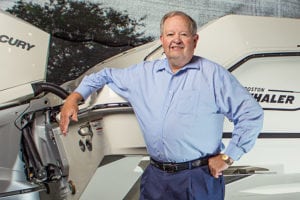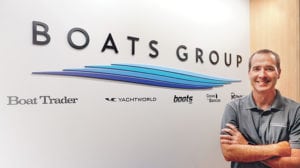2018 Boating Industry Movers and Shakers
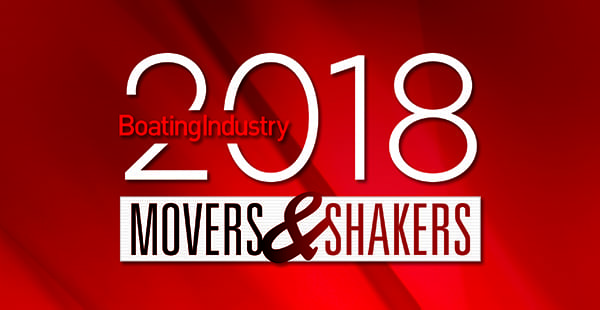
The 8th annual Movers & Shakers Awards recognize leaders who haven’t been afraid to take chances in rethinking the way they do business, while embracing the challenges facing the marine industry.
These leaders are people whose initiative and drive shake up and better their companies and the entire industry.
From product entrepreneurs to advocacy champions to leaders who continue to innovate, these 10 individuals are moving the boating industry forward into a bright and technology-driven future.
Here, we recognize our Mover & Shaker of the Year – Mark Schwabero, chairman and CEO of Brunswick Corp. – the finalists, and six other innovators who are shaking up the industry.
Mover & Shaker of the Year | Mark Schwabero
Chairman and CEO Brunswick Corp.
Mettawa, Ill.
As chairman and chief executive officer, Mark Schwabero continues to chart an ambitious course for the marine operations of Brunswick Corp.
Approximately 77 percent of Brunswick’s 2017 revenue – approximately $3.7 billion – was generated by its marine operations, including its engine segment, which manufactures and distributes marine propulsion systems and related parts and accessories, and the Brunswick Boat Group, which manufactures and distributes 14 recreational boat brands.
Combined marine revenues in 2017 were up about 8 percent from 2016, and combined marine operating earnings during the same period increased by more than 10 percent.
“And when we get to the end of 2018, 80 percent of our revenue will come from products that we’ve launched since 2012,” Schwabero added.
Beyond these sales gains and financial returns, Schwabero’s leadership has driven Brunswick’s continuing efforts to hone and execute a go-to-market strategy that not only advances the company within the global marine marketplace, but bolsters its fundamental strengths and capabilities to achieve those objectives.
Consumers want more features, reliable and enjoyable boating experiences. They expect greater conveniences and less maintenance with their boats and engines.
Acquisitions, enterprise improvement
A number of carefully calculated acquisitions and other enterprises have been completed since Schwabero became Brunswick’s chairman and CEO in 2014.
The successful acquisition of Power Products – Global Marine & Mobile is the largest ever undertaken by Brunswick Corp. in its nearly 175 years in business.
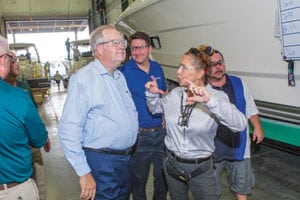
With its 11 leading brands, Power Products is a leading provider of branded electrical products, such as battery and power management and digital switching, to marine and other recreational and specialty vehicle markets.
The purchase of Power Products enables Mercury Marine to provide an electrical backbone for boat manufacturers and customers to ensure that systems and components function seamlessly together.
Mercury now has scope to provide boat OEMs with a turnkey boat integration system through digital architecture that allows such applications as remote monitoring of key functions and status and service integration with dealers.
This “electronic backbone” further serves to help future product development through such items as the engine diagnostics and other sensor-based data feeds that provide insight into reducing downtime, improving quality and tracking and deciphering consumer usage patterns.
The boat market recovery since the downturn of 2008 has evolved differently by segment, being redirected by numerous consumer preferences.
In light of such developments, Schwabero directed Brunswick to take a fresh and hard look at the marine marketplace and how the company was positioned for growth.
Mercury Marine responded with a game-changing rejuvenation and expansion of its outboard engine portfolio, culminating with unprecedented release of nearly 20 next-generation V8 and V6 Four-Stroke outboard engine models earlier this year.
The introductions represent the largest product development project in Mercury’s 79-year history.
Brunswick has invested more than $1.2 billion in Mercury’s global operations since 2009 aimed at enhancing Mercury Marine’s product range, quality, cost efficiency, capabilities and capacity.
Cost-control, brand reevaluation
The groundwork for all of Mercury’s recent advances was laid during Schwabero’s time as the division’s president, when he simultaneously directed continued investment in product development and attacked costs during the devastating downturn of 2008.
Among the measures undertaken was the difficult decision to consolidate Mercury’s manufacturing facility in Stillwater, Okla., where the company had made its sterndrive engines with Fond du Lac operations.
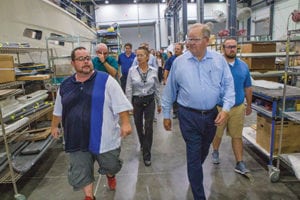
Mercury could not support the dedicated facility considering market developments, so operations were moved and consolidated at its operations in Wisconsin.
“Certain dates are burned in my mind,” Schwabero said. “One is July 15, 2009. We told the world that we had to take one of our manufacturing plants offline. It was a very interesting 45 days in my life. You have to remember where Brunswick was as a company, and where our stock price was. It was something that we just had to do.”
Likewise, under Schwabero’s direction, Brunswick recently took steps to adjust its boat portfolio.
The most recent example of which was the decision to wind down the production of sport yacht and yacht models at Sea Ray, while retaining the sport boat and cruiser portfolio.
“People need to know that we put Sea Ray through a process,” Schwabero said. “That process has come to a conclusion. I keep assuring dealers that we are committed to Sea Ray and the brand. We’ve been the owner of Sea Ray for 31 years, and we’ll probably own it for a much, much longer period.”
Industry, community involvement
During his tenure on several National Marine Manufacturers Association boards between 2008 and 2016, Schwabero provided leadership and guidance as NMMA and the industry navigated a recovery through the Great Recession.
Schwabero also served as chairman of the NMMA Executive Committee in 2013-14.
“We went through some painful times there, too,” he said. “Being able to continue to work on industry advocacy throughout the downturn was important. Once of the things that came to light was how everybody was trying to be heard. The main organization was fragmented. We were able to bring varied groups together.”
In addition to his business and industry association leadership, Schwabero is a fervent advocate of Brunswick and its operations being involved in community and other worthwhile causes.
When Hurricane Harvey pounded Houston in 2017, Brunswick sent more than 30 outboard engines, dozens of boats, 100 life jackets, tarps, bottled water and more to help rescue and recovery efforts.
“Our employees know that fundamentally, providing assistance during a time of need was an expectation that’s part of our corporate beliefs and strategy,” Schwabero said. “The most gratifying thing for me was watching how our organization responded.”
Diversity is the biggest challenge facing the boating industry, Schwabero said.
“We need to get different ethnic populations into boating, and from a demographic standpoint, we need to be attractive to millennials,” Schwabero contends, adding an associated task is changing fundamental parts of the boating business model.
“People’s product expectations keep moving up,” he added. “As an industry, we have to answer those expectations. Boating offers so much that’s meaningful to families and their time on the water. That’s the thought we have to keep at the forefront.”
Finalists | Tracy Crocker
 Senior Vice President and General Manager, Evinrude, and President, BRP Marine Group
Senior Vice President and General Manager, Evinrude, and President, BRP Marine Group
Sturtevant, Wis.
Tracy Crocker has more than 30 years of experience with global companies, including Proctor & Gamble, Pepsi, Nabisco, Ecolab, and Arctic Cat.
He’s an accomplished strategist and team leader, and has extensive experience in new product innovation and market business plan development.
Crocker joined Evinrude in 2017. This June, he was appointed president of BRP Marine Group with responsibility for group strategic direction and operations.
He continues to oversee business development for the Evinrude brand while reinforcing BRP’s commitment to become a leading global marine corporation.
“This is not a strategy to hang more engines on transoms. It’s a new business group’s strategy to sell more boats,” Crocker said, referring to BRP’s creation of a marine group.
Tossing A Two-Stroke Gauntlet
Following the launch of the E-TEC G2 in 2014, Evinrude set an industry standard for emissions, efficiency, and effectiveness.
However, Evinrude faced a unique challenge in making a reinvented two-stroke engine stand out among its four-stroke competitors.
“In the short-term, we want to complete the G2 horsepower rollout,” Crocker said. “We’ll be introducing several different horsepower categories in the near future. We’ve successfully rolled out everything from 150 horsepower to 300 horsepower. The ranges below 150hp will be next. After that, we want to create a platform and technology baseline that will help us connect the boat.”
In his role as Evinrude’s senior vice president and general manager, Crocker has been the driving force behind Evinrude’s efforts to change the global perception of two-stroke engines.
Traditional carborated two-stroke engines are viewed by many critics and some competitors as dirty and inefficient.
Italy’s parliament recently passed a legislative decree requiring all owners of an outboard engine with cubic capacity greater than 750cc and over 40 horsepower to possess a license in order to operate.
Evinrude and Crocker contend this decree was built upon the misunderstanding that all two-stroke engines are less environmentally friendly than four-stroke.
Evinrude’s direct injection two-stroke outboard engines have achieved over a 90 percent reduction in emissions and over a 50 percent reduction in fuel consumption compared to conventional two-stroke engines, Crocker said.
Crocker has developed and executed plans to elevate the message that Evinrude engines don’t just meet emissions standards, they exceed them at rates that far outpace traditional four-stroke emissions.
Evinrude conducted strategic outreach to Italian government officials and media to provide insight about the company’s advanced two-stroke engines.
Thanks to this outreach, over the course of several weeks, the Italian government introduced a legislative decree reversing the old legislation to protect owners of such engines affected.
This same message has traveled around the world and was recently included in Marine Business Australia in an article related to the country’s new emission standards.
“Those two markets are global leaders in how they set and implement their standards,” Crocker said. “We are excited about being able to be a leader in this area and tell our story on a global stage.”
Innovation beyond engines
Competing in the outboard engine market is about more than building quality engines. There’s a driving need to improve and create technology advancements to foster a well-rounded boating experience.
“I want to see the industry create more opportunities involving accessibility to boating, whether it’s subscription-based boating or price-value boats,” Crocker said. “We need to get the next generation passionate about boating.”
One issue important to boaters is the ability to dock a boat safely and effectively. That’s why Evinrude set out to market its iDock Joystick System as a solution that would be affordable for all boaters.
Arguably one of the biggest challenges Evinrude faces as a growing company is maintaining a strong marketshare and competing with other leaders in outboard engines.
For many years, due to a lack of boat partners, Evinrude has had to rely on repowering consumers to purchase their engines.
In order to ensure continuous growth and increase Evinrude’s market share, Crocker sought to change this tradition and expand Evinrude’s services.
“We think that fishing, in the broader sense, and the aluminum boat segment as a category have the most stability and growth,” Crocker said.
To take this strategy to the next level, Crocker spearheaded efforts for the Marine Group to acquire Minnesota-based Alumacraft.
“BRP is an agile, aggressive company,” Crocker contends. “In six short months, we built a strategy behind the scenes. We are excited about Alumacraft being the catalyst for an exciting opportunity.”
Crocker said making such an acquisition was definitely a goal when he met with BRP’s President and Chief Executive Officer José Boisjoli to discuss the marine group concept.
“We talked about it in theory,” he said. “The first task was making sure our new products were in the pipeline and ready for launch, and that’s good news. The industry was consolidating, and opportunities that we didn’t think were a reality came on the horizon.”
In early August, BRP also announced it had entered into a definitive agreement to acquire Triton Industries, Inc., the North American manufacturer of the Manitou pontoon brand.
Finalists | Samuel Fulton
CEO Sam Fulton joined Boats Group with the challenge of taking three of the leading online marketplaces in the boating industry – Boat Trader, YachtWorld and boats.com – to the next level.
Coming from Orbitz, Fulton worked to streamline the millions of options available for buying airfare and hotel rooms to create an easy, hassle-free experience for travelers around the world.
Fulton came to Boats Group to apply that same experience to the boating industry. The opportunities Fulton saw for the Boats Group portals included increasing traffic and leads by creating a world-class shopping experience for consumers while delivering leading value to dealers, brokers and OEMs.
“Over time, there’s been much more innovation in the hotel industry, and you’ve seen companies do a really good job of pulling together fragmented information to provide excellent consumer experiences to users,” Fulton said. “That same high-level data fragmentation exists in the boating industry. A Sea Ray is not a Sea Ray across the board, because each boat has variables such as differing hours on the engine, electronics packages and trim.”
Data metrics improve
He emphasizes using data to determine the company’s prioritization of site improvements, as well as the creation of new tools and products.
As a result of Fulton’s leadership, Boats Group’s metrics improved significantly. Year over year, the company’s online marketplaces tallied 20 percent more visitors, generated 11 percent more leads, and had 35 percent more boat sales from lead inquires coming from a Boats Group portal.
Currently, more than 60 percent of Boats Group site traffic comes from mobile devices. Fulton is continuing to push additional applications that put boat retailers’ inventory in front of more people across multiple devices. And under Fulton’s leadership, Boats Group has expanded its social media footprint and overall traffic coming from social media sources by 300 percent.
Earlier this year, a study by Boats Group in partnership with Info-Link Technologies, Inc provided an in-depth analysis of U.S. sales leads from three Boats Group sites: Boat Trader, YachtWorld and boats.com. Data from the lead conversion and sales study indicates lapsed boaters represent a critical recapture segment within the industry’s online marketplace.
One of the key factors revealed by the new analysis is the continuing rise of new boat sales, giving valuable insight into consumer trends across the boating industry as a whole.
Charting a new course
Fulton said he used his past experiences to chart a new data course for Boats Group. “I have a high level of intellectual curiosity,” he explained. “In the first 30 to 90 days, I was going through a huge learning curve, but one that was super exciting and interesting. I was able to look at all of the pieces of data that were out there, and how our business was leveraging them.”
The new BoatWizard mobile app is exclusive to brokers and dealers in the recreational boating space, designed to make it easier to access and manage inventory across the YachtWorld, Boat Trader, and boats.com platforms in real time, from any smartphone.
More than 25 percent of BoatWizard users downloaded the app as part of the initial launch. Many of these users were also part of a pre-launch test group, which provides feedback and input as new products are being developed. Fulton said that percentage has risen to 40 percent of Boats Group’s customer base.
The BoatWizard app now has more than 1,800 active users, Fulton added.
“If you think about apps in general, one of the beautiful things about what’s happened in the app space is that those who have totally embraced the mobile-first approach have had to solve very difficult user experience challenges,” Fulton explained. “We need the shopping experience in the boating space to be faster. We need to remove steps. We still have a lot of work to do.”
Lapsed boaters – individuals who have left the water or the boating lifestyle – represent a critical recapture segment within the industry’s online marketplace.
An in-depth analysis of U.S. sales leads on three Boats Group sites conducted earlier this spring by Info-Link Technologies, Inc. continues to provide additional consumer data for this key sector.
The firm evaluated more than 2.68 million unique consumer households across Boats Group’s portals between October 2013 and September 2017.
Over the last five years, new boat sales have been steadily increasing coinciding with the economic recovery. This is reflected both in the marketplace and among YachtWorld, Boat Trader and boats.com portal users.
Bringing back lapsed boaters
Sixteen percent of Boats Group users are actually lapsed boaters, people who are defined as previously owning a boat and have not owned a boat in the past year.
“What we’ve seen from the information that’s coming from our portals is that they are pretty successful in bringing lapsed boaters back into the industry,” Fulton said. “Our conversion rate is 26 percent. With regards to lapsed boaters, we’ve looked at our customer relationship programs to see if we are addressing the right segment.”
One of the things Fulton said he’s learned over time is that it’s critical to hire people who understand unique data perspectives.
“It’s important to realize that if you see a particular set of data, but you don’t understand why it’s important, it’s still important to store it and save it,” he said. “People who understand that are the most successful analysts. They always have an intense level of intellectual curiosity.”
Finalists | Amanda Levandowski
 Owner, Charlotte Ski Boats
Owner, Charlotte Ski Boats
Mooresville, N.C.
A decision by MasterCraft to open a new location within 25 miles on short notice was a surprise to Charlotte Ski Boats and Owner Amanda Levandowski.
The move ignited much confusion in the dealer’s marketplace, and increased financial risk, since MasterCraft tow boats accounted for 90 percent of unit sales.
“We were in the middle of closing on a property adjacent to our property that included a complete re-zoning,” Levandowski said. “We were closing on a million-dollar investment, and were two weeks away from completing it when we learned about the other dealer. When you have a major OEM make a decision that affects you, it’s not personal. It’s business. We had to make some decisions.”
While management recognized the potential risks of another MasterCraft dealer becoming a competitor, the development presented a unique opportunity to reevaluate a business model from the ground up, identify opportunities for business innovation, and make a push to ensure long-term financial sustainability.
“We never said anything negative about what happened,” she said, referring to the arrival of another MasterCraft dealer in Charlotte Ski Boat’s market area. “We took it as a positive, and also as a chance for us to improve our customer service.”
Marketplace competitive challenge
With less than two months notice of lead time to prepare for new competition, Levandowski realized how the immediate risks of customer confusion, reduced unit sales, and narrowing margins on unit sales would adversely affect financials.
Levandowski’s leadership in this process of transitioning Charlotte Ski Boats from a one product company to a more diversified business model was critical in right sizing, reengineering, and implementing a strategy to defend against immediate competition, while safeguarding the integrity built with suppliers, employees, and customers.
She immediately enrolled in a Spader’s Total Management weeklong training course, setting a clear set of proven principals, processes, and tools for the dealership to streamline performance and profitability.
Management, led by Levandowski, spent 60 days reconstructing the dealership’s financials to properly match expenses to revenues, measure departmental key performance ratios, and develop new department financial budgets.
“Our major unit inventory went from being marginally high to extremely high. The new dealership was taking 20-plus new MasterCraft units into a 60-to-70 new boat market,” Levandowski said. “We had just ordered 60 new units for the 2018 model year.”
Inventory analysis critical
Spader’s inventory management analysis reflected Charlotte Ski Boats was too heavy and would have to expect lower major unit margins. In addition, inventory hangover would take at least 12 to 18 months to get realigned, she said.
The dealership decided to diversify with another product line, opting for high-end Tahoe pontoons. The first order of 20 pontoons arrived the last week of May 2017.
The transition to the new line took time to learn, and dealership employees had to adapt quickly with only a few months remaining in the sales season.
“When we decided to take on a new manufacturer, we realized our software system was very antiquated,” Levandowski said. “It wasn’t doing the job and moving our dealership forward.”
Charlotte Ski Boats opted to upgrade its dealer management software from Top-Line to CDK Global’s Lightspeed, implementing real-time financial reporting for more effective management, and time-saving data integration, Levandowski said.
Charlotte Ski Boats also constructed a new service facility to handle the increased demand of servicing customers’ boats, reducing reliance on unit sales.
Service sales rose, increasing overall profitability and boosting tech service efficiencies to more than 70 percent over a six-month period, Levandowski said.
Levandowski actively shares the boating lifestyle through her professional and community involvement. Charlotte Ski Boats offers water sports camps to more than 1,000 kids each year. She is also actively involved in the Water Sports Industry Association and supports numerous community organizations in the Mooresville, N.C. area through hosted events and promoted sponsorships.
Boating community, helping kids
“It’s incredible to see the transformation and improvement in self-esteem kids get after they get out on the water, and try wake boarding,” she said. “It’s the happiest time of their lives. It’s rewarding to change their lives, and their parents.”
Levandowski became the bread-winner for her family after her father lost a courageous battle against cancer. In her early 20s, she was a partner in a mortgage company, and at age 25 she graduated from Queen’s College McColl School of Business. After selling her business, she started in sales at Charlotte Ski Boats, where she’s been a top MasterCraft sales person the last three years.
“I later realized the reason that I wanted to go to law school was because I wanted to change the world, and the way that people think, and the way kids are raised,” she said. “I’ve come to realize what I’m doing every day in the boating industry far surpasses anything that I could have done as an attorney.”
Levandowski remains highly positive and enthusiastic about embracing the continued changes that are affecting boating industry dealers. She’s always willing to talk to others about business improvement.
“Make sure you understand who you want to be as a dealer,” she advises. “You can’t be everything to everyone, but decide on who you want to be and what you stand for. If every boat dealer and different organization in our industry did that, more people would see things as opportunities, not as obstacles.”

